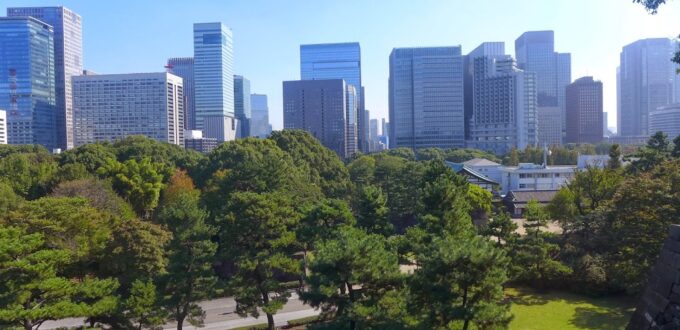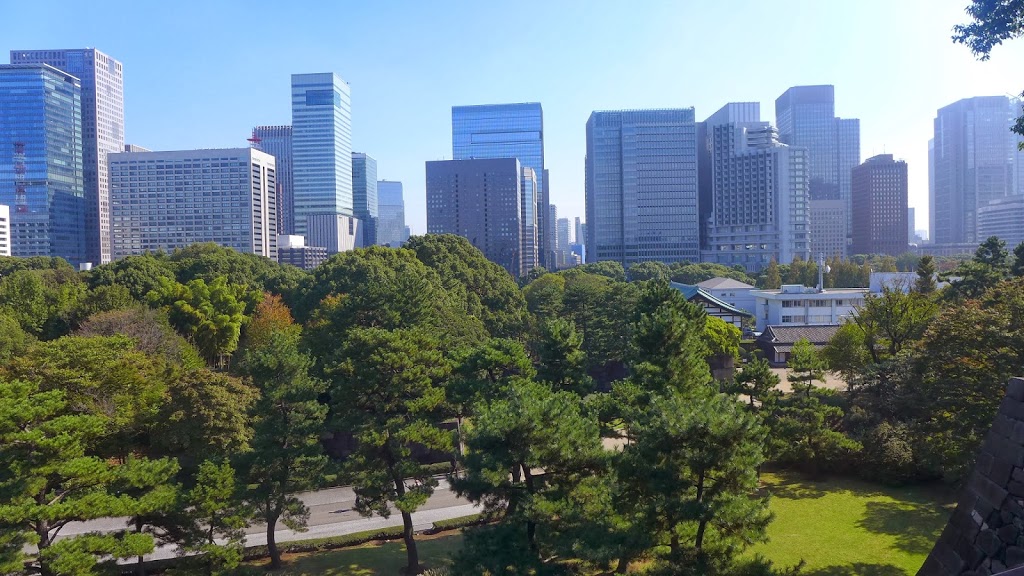 |
| Trees and skyscrapers, my favourite combination |
Today morning we packed, left Guillaume’s keys in his mailbox and, having several hours left until our flight to Sapporo, we went to the imperial gardens. This time – success, it’s open! Nice park, big defensive walls, view of some palace buildings from a distance… No chance to visit the Emperor, sadly. We learned a lot about him, though, thanks to Eva’s supreme research skills. So here are some assorted facts about the Japanese Empire:
 |
| Imperial gardens |
 |
| I has a big stone |
 |
| So this is where it came from… |
The Japanese imperial dynasty is the longest unbroken dynastic chain in the world: 125 consecutive rulers, with no single break in continuity, staring some time in 6 century BC, all one family (the first 25 emperors are shrouded in some obscurity of the ages past, but even without them that’s impressive!). For a good several centuries the emperors had absolutely no power – the dynasty continued, while the real power was held by the shogunates. They regained power in 1867, following a civil war against the Edo shogun, with Emperor Meiji assuming absolute reign. From being completely unimportant, the Emperor suddenly had enough power to introduce a complete cultural revolution. Hirohito, the Emperor who encouraged fascism, sent children to fight in a lost war, ordered use of chemical weapons, didn’t surrender even after devastating air raids which killed half the population of Tokyo, and advised all the Japanese to commit suicide rather than live through Japan’s surrender – that guy not only was never tried for war crimes, but continued to rule until 1987! Currently, the Emperor has less real power than the queen of Britain – his role is purely ceremonial and in part religious, but emperors are not gods of Shinto anymore. Everyone from the imperial dynasty but the closest family of the Emperor is just a regular citizen. The Emperor is not allowed to publicly express his opinion, he’s not even allowed to have a surname.
 |
| Lato October in Tokyo |
Two of my questions remain unanswered: why did the anti-shogun faction gave the power to the Emperor rather than take it themselves? If all of the imperial family are demoted to regular citizen status, the imperial dynasty has to continue, and the Emperor isn’t allowed to marry just anyone, then whom can emperors marry? If you know the answers, let me know.
 |
| Noms |

The journey to Sapporo took us from the land of late summer to late autumn. And autumn is beautiful on Hokkaido – the leaves turning yellow and red, strong sun, fresh air… We took a train to town, walked around a bit, but it was getting dark and cold. We found a really cool restaurant – one in which we were sat in a classy cubicle with fancy cushions, and which served most interesting food. We took chicken wings with bones replaced with stuffing, octopus dumplings, a salad with interesting deep fried bitter gourd rings, and an okonomiyaki – a sort of quiche-pancake-omelette topped with mega thin grated tuna ‘petals’ which moved all the time! And mango ice cream desert with amazingly thick whipped cream. Fantastic!
 |
| Not only I make silly faces on pictures, see? |
We then went to our host’s home. Kazu is a grad student (researches collagen and tries to find new uses for animal skin and joining tissues which often go to waste) and we were really happy to see Japan from this perspective for a change. Kazu’s friends were around and cooked some more cool food (pickled mackerel with avocado and seaweed, seafood risotto, and candied salmon with nori), then his two flatmates joined us. Apparently home sharing and having flatmates is rather rare in Japan, so we got to stay with some alternative folk. We had some good chats and were happy to be able to sleep on sofas rather than the floor for a change.
Turns out Kazu’s first name is actually Kazuichi. It literally means ‘first son’. Apparently the Japanese are as bothered with names as ancient Romans – what’s your fifth son’s name? Quintus, of course. Boys’ names generally end in ‘ro’, messaging ‘clear, bright’, or ‘ta’ – ‘ great, thick’, or ‘dai’ – ‘great, large’. Girls names end in ‘ko’, meaning ‘child’, or ‘mi’ – ‘beauty’, or ‘ka’ – scent, flower. Hooray sexism. Not that this was the only thing in which sexism was visible here – the infantilisation of women is the standard.
One more reflection on being alternative in Japan. Turns out that there was a subculture of girls here who are considered to be relentless, outrageous and generally a bad influence – Sukeban. They distinguish themselves starkly with their appearance: they… wear slightly longer skirts and might dye their hair. Turns out that was is enough to make you a rebel in Japanwa in the 90s. I can’t say that this surprises me, considering all the suits on the streets – looks like just wearing a t-shirt would make you alternative.







 The journey to Sapporo took us from the land of late summer to late autumn. And autumn is beautiful on Hokkaido – the leaves turning yellow and red, strong sun, fresh air… We took a train to town, walked around a bit, but it was getting dark and cold. We found a really cool restaurant – one in which we were sat in a classy cubicle with fancy cushions, and which served most interesting food. We took chicken wings with bones replaced with stuffing, octopus dumplings, a salad with interesting deep fried bitter gourd rings, and an okonomiyaki – a sort of quiche-pancake-omelette topped with mega thin grated tuna ‘petals’ which moved all the time! And mango ice cream desert with amazingly thick whipped cream. Fantastic!
The journey to Sapporo took us from the land of late summer to late autumn. And autumn is beautiful on Hokkaido – the leaves turning yellow and red, strong sun, fresh air… We took a train to town, walked around a bit, but it was getting dark and cold. We found a really cool restaurant – one in which we were sat in a classy cubicle with fancy cushions, and which served most interesting food. We took chicken wings with bones replaced with stuffing, octopus dumplings, a salad with interesting deep fried bitter gourd rings, and an okonomiyaki – a sort of quiche-pancake-omelette topped with mega thin grated tuna ‘petals’ which moved all the time! And mango ice cream desert with amazingly thick whipped cream. Fantastic!


No Comments Yet